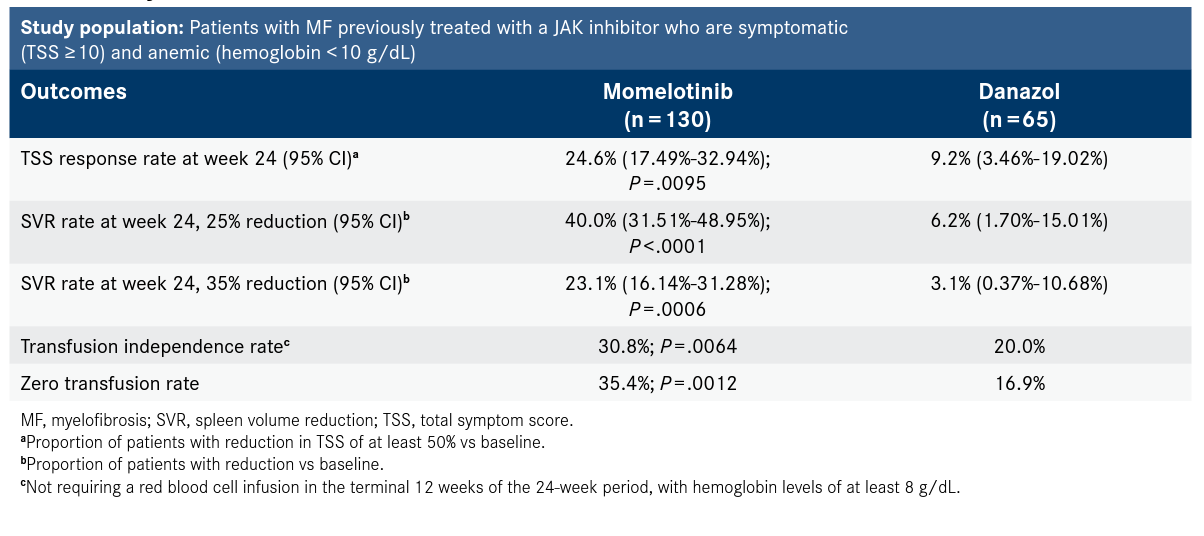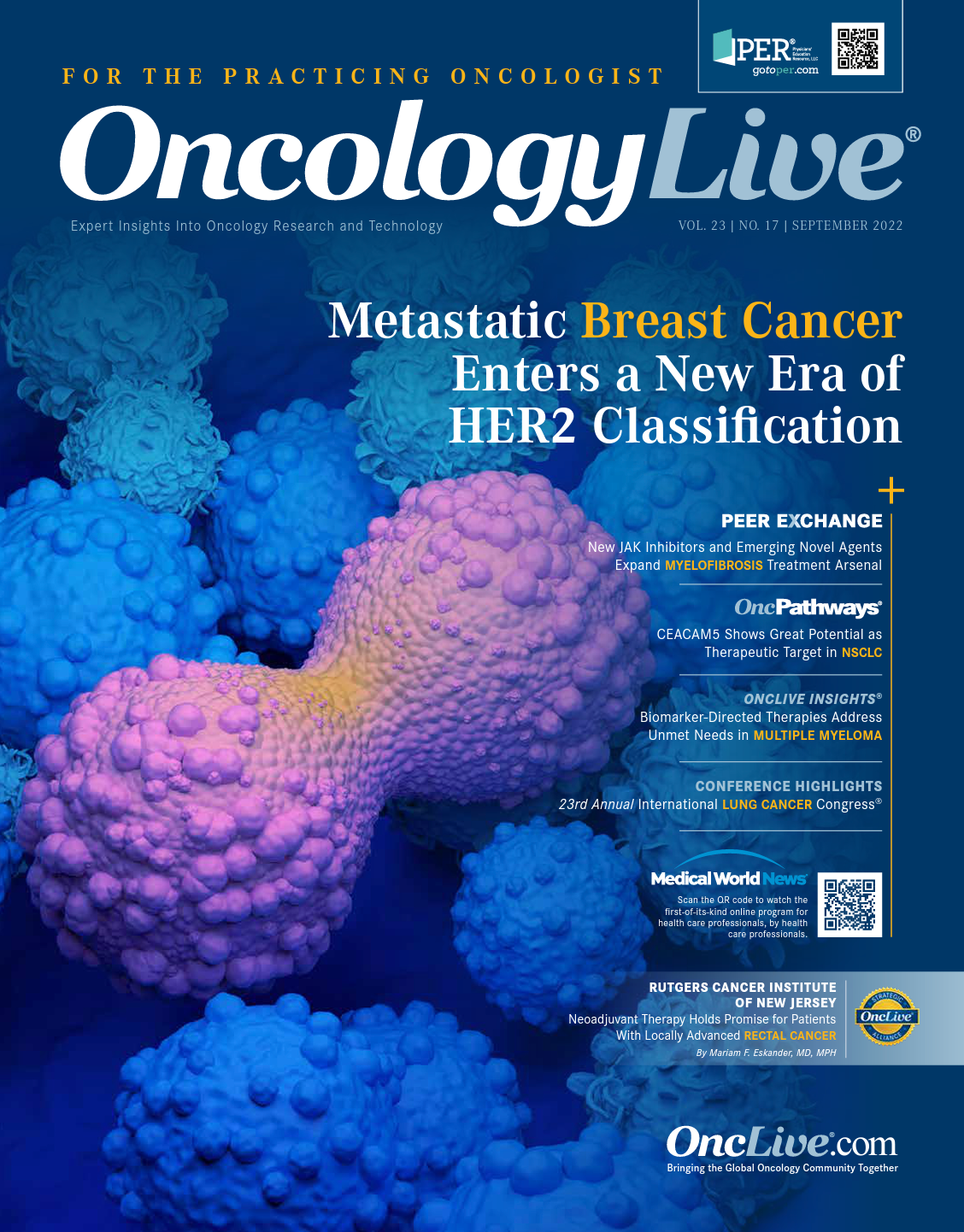Publication
Article
New JAK Inhibitors and Emerging Novel Agents Expand Myelofibrosis Treatment Arsenal
Author(s):
A panel of hematology cancer experts discuss the current treatment landscape and novel emerging therapies for patients with myelofibrosis.
Rami Komrokji, MD

For patients with myelofibrosis (MF), stem cell transplant continues to be the only curative treatment. Many patients, however, may not be eligible for transplants, including older adults or those whose disease is not yet deemed of high enough risk to warrant transplant. In these patients, medical treatments are crucial to control their symptoms and improve their overall quality of life.
In terms of myeloproliferative neoplasms, MF “is probably the most symptomatic disease, with a high burden on patients and worse outcome in general,” Rami Komrokji, MD, said during a recent OncLive Peer Exchange®. Komrokji served as moderator for a panel of hematology cancer experts who discussed the current treatment landscape and novel emerging therapies for patients with MF.
JAK Inhibitors
Three JAK inhibitors have been approved for patients with MF: ruxolitinib (Jakafi), fedratinib (Inrebic), and pacritinib (Vonjo). Momelotinib is on track to become the fourth FDA-approved JAK inhibitor.
Ruxolitinib
Ruxolitinib has been the standard of care for many patients with MF since 2011, when it became the first FDA-approved treatment for patients with MF. The initial approval was for patients with intermediate/high-risk primary or secondary MF based on data from the COMFORT-I (NCT00952289) and COMFORT-II (NCT00934544) trials.1 Both studies showed statistically significant reductions in spleen volume and improvement in total symptom scores (TSSs). “It was transformative because we had a treatment that improved patients’ quality of life and reduced spleen size,” Jamile Shammo, MD, said.
During the 2022 American Society of Clinical Oncology Annual Meeting (2022 ASCO) in June, a retrospective review of the medical records of 131 patients who received ruxolitinib for 3 or more years was presented.2 The study found that 40% of patients who remained on ruxolitinib for 3 or more years were alive 10 years after their treatment initiation. On multivariate analysis, age 65 years or older and neutropenia were predictive factors of survival.
“It’s a very good option for patients who have this disorder. We need to keep an eye on things like opportunistic infections—herpes zoster is 1 such issue—and cytopenias, which can be managed,” Shammo said.
Fedratinib
Fedratinib became the second FDA-approved JAK inhibitor for patients with intermediate-2 or high-risk primary or secondary MF when it was finally approved in 2019 based on data from the JAKARTA (NCT01437787) and JAKARTA-2 (NCT01523171) studies.3 Its development had been slowed because it was placed on a clinical hold between 2013 and 2017.3
“Approval of the drug was delayed because there was a very low rate of Wernicke encephalopathy [WE], probably interfering with thiamine metabolism to a small degree,” Ruben Mesa, MD, explained. WE had been observed in 1.3% of patients (8 of 608 study participants).
“There’s a black box warning that sounds scary but in practice is fairly simple. You check thiamine levels, and you replace thiamine, and thiamine is dirt cheap. I give patients a bottle. Then you monitor for Wernicke,” Mesa said.
Once it was determined that fedratinib does not directly induce WE and that the risk of the complication can be mitigated, the FDA approved it. Data from the JAKARTA studies showed statistically significant responses in spleen volume reduction (SVR) and MF symptoms.3 “If [patients] used ruxolitinib and still have [an enlarged] spleen and symptoms, and you don’t have a trial available, fedratinib is a good option. It can be used at full dose in patients with platelets between 50,000 and 100,000 per mm3,” Mesa said.
Pacritinib
Pacritinib received an accelerated approval from the FDA in February 2022 for adult patients with intermediate or high-risk primary or secondary MF based on data from the pivotal phase 3 PERSIST-2 (NCT02055781) study.4,5 PERSIST-2 randomly assigned 311 patients 1:1:1 to receive pacritinib 200 mg twice daily (n = 107), pacritinib 400 mg once daily (n = 104 patients), or best available therapy (BAT; n = 100), usually ruxolitinib (45% of patients). Prior JAK2 inhibitor therapy was permitted.
At week 24, the intention-to-treat efficacy population included 72 to 75 patients in each arm, and significantly more patients in the pacritinib arms vs BAT arm had SVR of 35% or greater (18% vs 3%, respectively; P = .001). Additionally, pacritinib- vs BAT-treated patients had a nonsignificantly higher rate of reduction in TSS of 50% or greater (25% vs 14%, respectively; P = .08). When comparing pacritinib dosing, pacritinib 200 mg twice daily was found to be the most efficacious, demonstrating significant reductions in both spleen volume and TSS vs BAT, with 22% vs 3% (P = .001), respectively, experiencing SVR, and 32% vs 14% (P = .01), respectively, experiencing reduction in TSS of 50% or greater.
Unlike ruxolitinib and fedratinib, pacritinib can be used irrespective of patients’ platelet counts and in the setting of marked thrombocytopenia. Mesa explained that this has been attributed to its inhibition of IRAK1. “It might be better for patients with cytopenic MF. In clinical studies, it could be used safely and effectively in individuals with platelet counts of less than 50,000 per mm3. It’s approved for individuals with marked thrombocytopenia in the front line and second line. It might also help to improve anemia,” he said, noting it is the first approved therapy that addresses the needs of patients with cytopenic MF, a group who previously had no treatment options.
Momelotinib
Momelotinib, a highly selective JAK inhibitor, is being developed for patients with MF who are symptomatic and anemic. GSK has submitted a new drug application for momelotinib based on data from several studies, including the phase 3, randomized, double-blind MOMENTUM (NCT04173494) trial. The FDA is scheduled to make a decision by June 16, 2023.6
“[Momelotinib is] a JAK1 and JAK2 inhibitor that we had noticed early on could help improve anemia. Just as we had learned early on that pacritinib may have less thrombocytopenia, momelotinib had something different. It might help to improve anemia and have less drug-emergent anemia,” Mesa said.
Momelotinib was first assessed in the phase 3 SIMPLIFY-1 (NCT01969838) and SIMPLIFY-2 (NCT02101268) trials.7,8 In SIMPLIFY-1, 432 patients with either high-risk, intermediate-2 risk, or symptomatic intermediate-1 risk MF who had not received JAK inhibitor therapy were randomly assigned to 24 weeks of momelotinib 200 mg once daily or ruxolitinib 20 mg twice daily, after which all patients could receive open-label momelotinib.7 At 24 weeks, momelotinib was found to be noninferior to ruxolitinib for spleen response and inferior for symptom response, but momelotinib was associated with a reduced transfusion requirement.
“If we look at that analysis now, not inferior [for symptom response] probably would have been more accurate. But without question, it was better for anemia,” Mesa said. He explained that a multicenter analysis he participated in investigated the mechanism behind the improvement in anemia and discovered it was due to momelotinib’s suppression of hepcidin and inhibition of ACVR1.
SIMPLIFY-2 compared momelotinib with BAT in 156 patients with MF previously treated with ruxolitinib.8 At 24 weeks of treatment, 73 of 104 patients (70%) in the momelotinib arm and 40 of 52 patients (77%) in the BAT arm (ruxolitinib in 89% of patients) were still on treatment. Momelotinib was not superior to BAT in demonstrating a greater than 35% reduction in spleen size compared with baseline, with 7% vs 6% of patients, respectively, achieving this end point.
Because the data from SIMPLIFY-1 and SIMPLIFY-2 were muddy, the MOMENTUM trial was initiated to provide clarity. “We created the MOMENTUM study to have a very specific additional set of data that we thought were critical: second-line, symptomatic, and anemic patients who [did not have success with] ruxolitinib, and with a control arm that we think was arguably demonstrating that we don’t have a lot as it relates to anemia. But we do have danazol, an androgen,” Mesa said.
Data for the MOMENTUM trial were presented at 2022 ASCO (Table).9 The trial compared momelotinib with danazol in 195 patients with MF previously treated with a JAK inhibitor who were symptomatic and anemic.9 Patients were randomly assigned 2:1 to receive momelotinib 200 mg once daily plus danazol placebo (n = 130) or danazol 600 mg once daily plus momelotinib placebo (n = 65) for 24 weeks, after which patients could receive open-label momelotinib. At 24 weeks, 72.3% of patients in the momelotinib arm and 58.5% of patients in the danazol arm completed treatment, with 70.8% and 55.4% of these patients, respectively, entering the momelotinib open-label extension.
Table. Key Data for Momelotinib in the MOMENTUM trial9

Momelotinib was found to be superior to danazol in almost all end points assessed, including TSS response rate (24.6% vs 9.2%, respectively; P = .0095), SVR of at least 25% (40.0% vs 6.2%, respectively; P < .0001) and of at least 35% (23.1% vs 3.1%, respectively; P = .0006]), change in TSS from baseline (–9.36 vs –3.13, respectively; P = .0014), and zero transfusion rate (35.4% vs 16.9%, respectively; P = .0012). Momelotinib showed noninferiority to danazol in transfusion independence rate at 24 weeks (30.8% vs 20.0%, respectively; P = .0064). There was a trend toward improved overall survival (OS) with momelotinib vs danazol (HR, 0.506; 95% CI, 0.2381.076; P = .0719).
Overall, momelotinib demonstrated a good safety profile. The most common treatment-related adverse effects (TRAEs) of grade 3 or greater severity included thrombocytopenia, which occurred in 22% of patients in the momelotinib arm and 12% of patients in the danazol arm; anemia, which occurred in 8% and 11% of these patients, respectively; and infections, which occurred in 15% and 17%, respectively. In all, TRAEs led to study discontinuation in 18% of momelotinib-treated patients and 23% of danazol-treated patients.
Similar findings were reported in a poster presented at 2022 ASCO that examined the safety and efficacy of momelotinib vs danazol among participants in MOMENTUM based on their baseline platelet counts.10 The assessment found that thrombocytopenic patients with platelet counts as low as 25 × 109/L could be treated safely with momelotinib and showed improvements in symptom responses, splenic responses, and transfusion independence rates compared with danazol. As in the overall intention-to-treat population, platelet levels in thrombocytopenic patients were found to remain stable over time, and the trend toward improved OS was maintained.
“When we look at the experience of momelotinib in aggregate, it clearly paints a picture of a drug that would be very helpful to have in MF….It will have roles in some patients in the front line and clearly some patients in the second line. It will make a significant addition to the armamentarium if the drug is approved after all these data are reviewed by the FDA,” Mesa said.
Emerging Treatments
In addition to JAK inhibitors, a variety of other novel agents with unique mechanisms of action are being tested in clinical trials as potential treatments for MF. The panelists indicated that some of these agents may lend themselves to promising combination approaches, particularly in combination with ruxolitinib, as well as provide patients with options after JAK2 inhibitor failure.
Navitoclax (ABT-263)
Navitoclax, a cousin of venetoclax (Venclexta), is an orally bioavailable small-molecule inhibitor of BCL2.11 Targeting the BCL-XL pathway has been shown to overcome JAK inhibitor resistance in preclinical models.11 “For many reasons, it’s been speculated that the combination of trying to overcome apoptotic resistance and having JAK inhibition could be beneficial,” Mesa said.
Recently, data from the phase 2 REFINE trial (NCT03222609) were reported. The study assessed the addition of navitoclax to ruxolitinib for patients with MF and progression or suboptimal response while on a stable dose of ruxolitinib (≥ 10 mg twice daily).11 At week 24, the addition of navitoclax to ruxolitinib was found to result in durable SVR of 35% or greater and improvements in TSS, hemoglobin response, and change in bone marrow fibrosis grade. Two phase 3 trials exploring the potential of the combination of navitoclax and ruxolitinib to modify the course of the disease are underway: TRANSFORM-1 (NCT04472598) in patients who have not received JAK2 inhibitors and TRANSFORM-2 (NCT04468984) in patients whose disease has progressed or who have had a suboptimal response to ruxolitinib therapy. The comparison arms in the trials are ruxolitinib plus placebo and BAT, respectively.11
Pelabresib (CPI-0610)
Pelabresib is an investigational small molecule BET inhibitor that was assessed in the phase 1/2 MANIFEST trial (NCT02158858).12 In the study, pelabresib monotherapy showed signs of clinical activity in patients with advanced MF who were ineligible for JAK inhibitor therapy, including SVR, symptom improvement, and hemoglobin benefit.12
Pelabresib is currently being assessed in the ongoing, global, phase 3, double-blind, randomized, placebo-controlled phase 3 MANIFEST-2 (NCT04603495) trial.13 MANIFEST-2 investigators are planning to enroll up to 400 patients with intermediate-1 or higher primary or secondary MF who have not been treated with a JAK inhibitor.
Patients will be treated with ruxolitinib twice daily on days 1 to 21 in 21-day cycles and randomly assigned 1:1 to receive concomitant pelabresib or concomitant placebo orally once daily on days 1 to 14 of treatment. The primary end point will be SVR of 35% or greater at 24 weeks, and the secondary end point will be reduction in TSS of 50% or greater from baseline at 24 weeks.
“BET inhibition does provide a novel mechanism of treating MF, which will hopefully help and boost not only the effectiveness of ruxolitinib, the duration of time that it’s working, but also perhaps have some type of effect on the natural history of the disease,” Jeanne M. Palmer, MD, said.
Imetelstat (GRN163L)
Imetelstat, a telomerase inhibitor, was evaluated in the phase 2, multicenter MYF2001 (NCT02426086) trial, which assessed 2 doses of imetelstat monotherapy in patients with relapsed or refractory intermediate-2 or high-risk MF previously treated with a JAK inhibitor.14 Patients were randomly assigned to receive either imetelstat 9.4 mg/kg or 4.7 mg/kg intravenously once every 3 weeks. Imetelstat 9.4 mg/kg showed clinical benefits. The median OS was 29.9 months among 59 patients who received the higher dose, with improvement in bone marrow fibrosis in 40.5% of 37 evaluable participants in that group. Additionally, 42.1% of patients treated with the higher dose had a reduction in the variant allele frequency of driver mutations, suggesting effects on the malignant clone.
“In the groups that have ruxolitinib failure, many studies have shown a survival in the range of a year and a half or less,” Komrokji said, indicating that the almost 30 months seen with imetelstat suggests an OS benefit.
Komrokji and colleagues came to this determination after comparing the findings in the MYF2001 trial with external real-world data that were collected from a study of 96 patients who had discontinued ruxolitinib and were subsequently treated with BAT at Moffitt Cancer Center in Tampa, Florida.15
The real-world comparison showed BAT to have a 12-month OS in closely matched patients with MF after JAK inhibitor failure. Based on this OS signal, imetelstat is currently being assessed in the phase 3 MYF3001 trial (NCT04576156) comparing imetelstat with BAT in patients with intermediate-2 or high-risk MF who have not responded to JAK inhibitor treatment.16
References
- Mascarenhas J, Hoffman R. Ruxolitinib: the first FDA approved therapy for the treatment of myelofibrosis. Clin Cancer Res. 2012;18(11):30083014. doi:10.1158/1078-0432.CCR-11-3145
- Masarova L, Bose P, Pemmaraju N, et al. Characteristics of patients with myelofibrosis on ruxolitinib for three or more years. J Clin Oncol. 2022;40 (suppl 16):e19082. doi:10.1200/JCO.2022.40.16_suppl.e19082
- Mullally A, Hood J, Harrison C, Mesa R. Fedratinib in myelofibrosis. Blood Adv. 2020;4(8):1792-1800. doi:10.1182/bloodadvances.2019000954
- CTI BioPharma announces FDA accelerated approval of VONJO (pacritinib) for the treatment of adult patients with myelofibrosis and thrombocytopenia. News release. CTI BioPharma Corp. February 28, 2022. Accessed August 14, 2022. https://bit.ly/3K0e743
- Mascarenhas J, Hoffman R, Talpaz M, et al. Pacritinib vs best available therapy, including ruxolitinib, in patients with myelofibrosis: a randomized clinical trial. JAMA Oncol. 2018;4(5):652-659. doi:10.1001/jamaoncol.2017.5818
- US FDA accepts new drug application for GSK’s momelotinib for the treatment of myelofibrosis. News release. GSK plc. August 17, 2022. Accessed August 19, 2022. https://bit.ly/3Ck8R9A
- Mesa RA, Kiladjian JJ, Catalano JV, et al. SIMPLIFY-1: a phase III randomized trial of momelotinib versus ruxolitinib in Janus kinase inhibitor-naïve patients with myelofibrosis. J Clin Oncol. 2017;35(34):3844-3850. doi:10.1200/JCO.2017.73.4418
- Harrison CN, Vannucchi AM, Platzbecker U, et al. Momelotinib versus best available therapy in patients with myelofibrosis previously treated with ruxolitinib (SIMPLIFY 2): a randomised, open-label, phase 3 trial. Lancet Haematol. 2018;5(2):e73-e81. doi:10.1016/S2352-3026(17)30237-5
- Mesa RA, Gerds AT, Vannucchi A, et al. MOMENTUM: phase 3 randomized study of momelotinib (MMB) versus danazol (DAN) in symptomatic and anemic myelofibrosis (MF) patients previously treated with a JAK inhibitor. J Clin Oncol. 2022;40(suppl 16):7002. doi:10.1200/JCO.2022.40.16_suppl.7002
- Gerds AT, Verstovsek S, Vannucchi A, et al. Thrombocytopenic myelofibrosis patients previously treated with a JAK inhibitor in a phase 3 randomized study of momelotinib versus danazol [MOMENTUM]. J Clin Oncol. 2022;40(suppl 16):7061. doi:10.1200/JCO.2022.40.16_suppl.7061
- Harrison CN, Garcia JS, Somervaille TCP, et al. Addition of navitoclax to ongoing ruxolitinib therapy for patients with myelofibrosis with progression or suboptimal response: phase II safety and efficacy. J Clin Oncol. 2022;40(15):1671-1680. doi:10.1200/JCO.21.02188
- Kremyanskaya, M, Mascarenhas J, Palandri F, et al. Pelabresib (CPI-0610) monotherapy in patients with myelofibrosis – update of clinical and translational data from the ongoing manifest trial. Blood. 2021;138(suppl 1):141-144. doi:10.1182/blood-2021-150172
- Harrison CN, Gupta VK, Gerds AT, et al. Phase III MANIFEST-2: pelabresib + ruxolitinib vs placebo + ruxolitinib in JAK inhibitor treatment-naive myelofibrosis. Future Oncol. Published online August 11, 2022. doi:10.2217/fon-2022-0484
- Mascarenhas J, Komrokji RS, Palandri F, et al. Randomized, single-blind, multicenter phase II study of two doses of imetelstat in relapsed or refractory myelofibrosis. J Clin Oncol. 2021;39(26):2881-2892. doi:10.1200/JCO.20.02864
- Kuykendall AT, Sun L, Mascarenhas J, et al. Favorable overall survival with imetelstat in relapsed/refractory myelofibrosis patients compared with real-world data. Ann Hematol. 2022;101(1):139-146. doi:10.1007/s00277-021-04683-w
- A study comparing imetelstat versus best available therapy for the treatment of intermediate-2 or high-risk myelofibrosis (MF) who have not responded to Janus kinase (JAK)-inhibitor treatment. ClinicalTrials.gov. Updated July 27, 2022. Accessed August 14, 2022. https://clinicaltrials.gov/ct2/show/NCT04576156










